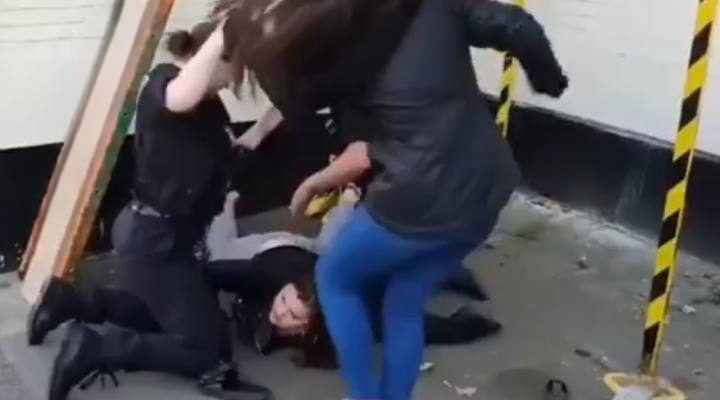NEW YORK — August 25, 2024 — A video capturing a police arrest that escalated into physical confrontation, in which an officer was seen kicking a woman, has sparked widespread public outcry and renewed debate about law enforcement’s use of force in the United States. The incident, recorded by bystanders and shared across social media platforms, has drawn attention not only because of what is seen in the footage but also because of the broader questions it raises about police accountability, training, and proportional responses during tense encounters.
The Incident: What the Video Shows
According to eyewitness recordings and statements, the event unfolded when three police officers—two men and one woman—attempted to detain a woman during what appeared to be a routine enforcement action. The officers restrained the woman, eventually forcing her onto her knees in preparation to apply handcuffs.
At that moment, another woman, identified by observers as a friend of the first detainee, suddenly approached the group. The second woman reportedly shoved the female officer in an effort to disrupt the arrest. In response, one of the male officers reacted by stepping forward and delivering a forceful kick, knocking the woman backward.
Bystanders can be heard shouting in alarm as the kick landed. The video spread quickly online, generating intense discussions about the level of force used and whether it aligned with established standards of law enforcement conduct.
Immediate Reactions
Civil rights advocates, legal experts, and community leaders were quick to weigh in. While most acknowledged that interfering with an arrest is a violation of the law and can justify a defensive police response, many questioned whether a kick was proportionate to the perceived threat.
“Officers have the right and the duty to ensure their safety and maintain control of the situation,” explained a spokesperson from a civil liberties watchdog group. “However, the method of response matters. A kick may escalate rather than calm the situation, particularly when the individual is unarmed and the perceived threat is minimal.”
Others highlighted the optics of the event. In an era where nearly every police interaction can be recorded and shared instantly, the choice of tactics carries not only legal consequences but also reputational costs for the department involved.
Use-of-Force Policies: A Complex Framework
Most police departments in the United States follow a use-of-force continuum—a structured guideline that outlines appropriate levels of force depending on the subject’s behavior. These levels typically begin with officer presence and verbal commands, escalating to physical control techniques, and, in extreme cases, the use of deadly force.
Within this continuum, physical strikes such as punches or kicks are generally considered intermediate tactics. They are often reserved for scenarios where a subject poses an active physical threat to the officer or others. For many critics, the concern in this case lies in whether the woman’s push constituted such a threat.
Experts note that the line between “reasonable” and “excessive” force is not always clear-cut. Courts often apply a standard based on what a “reasonable officer” would have done in the same situation, considering the circumstances in real time rather than with the benefit of hindsight.
Accountability and Review
The police department involved has confirmed that the incident is under internal investigation. As with most use-of-force cases, internal affairs officers will examine the video, review body camera footage (if available), and interview those directly involved, as well as witnesses.
Possible outcomes include exoneration, retraining requirements, suspension, or disciplinary action against the officer. In extreme cases, officers found to have violated laws or department policy may face termination or even criminal charges.
The review process is often lengthy and controversial, with communities divided between those calling for strict accountability and those emphasizing the need to give officers the benefit of the doubt in high-pressure scenarios.
A Broader Debate: Policing in the Spotlight
The video has reignited national conversations about policing, public safety, and community trust. Over the past decade, numerous high-profile incidents involving alleged police misconduct have spurred reforms, protests, and demands for change.
Advocates for reform argue that law enforcement agencies must invest more in de-escalation training, mental health awareness, and community engagement. They stress that preventing escalation should be the top priority in interactions, especially in cases where subjects are unarmed.
Critics of police reform movements, on the other hand, argue that officers operate in unpredictable and dangerous environments where hesitation could place their lives—and the lives of civilians—at risk. They emphasize the importance of supporting officers’ judgment calls in the field.
Community Response
Reactions from the community where the incident occurred have been strong. Many residents expressed frustration, saying that trust in law enforcement has already been fragile and incidents like this further erode confidence. Others defended the officers, suggesting that critics underestimate the challenges faced during volatile arrests.
“I understand people are upset when they see something like that on video,” said one resident interviewed by local media. “But we also have to think about what the officer was experiencing in the moment. If someone suddenly pushes an officer during an arrest, that’s a dangerous situation.”
Another community member took the opposite view: “This is exactly why people don’t trust the police. That woman didn’t have a weapon. There were already three officers on the scene. Why was a kick necessary?”
Legal Perspectives
Legal scholars point out that the video will be central if lawsuits or criminal charges arise. Courts often weigh the Graham v. Connor (1989) standard, which requires assessing whether force was “objectively reasonable” under the circumstances. Factors include the severity of the crime, whether the suspect posed an immediate threat, and whether the suspect was resisting arrest.
In this case, analysts argue, the crime involved interference with an arrest—an offense, but not typically a violent or life-threatening one. Whether the officer’s kick met the threshold of “reasonable” force will likely be the crux of the debate.
Police Training and Reform Efforts
The incident has also renewed attention to ongoing discussions about police training. Many departments now require scenario-based training in de-escalation and emphasize communication over confrontation. Critics say these reforms have been unevenly implemented, with some officers continuing to default to aggressive tactics.
Advocates argue that better training could have prevented this situation from escalating. For example, instead of responding with a kick, the officer could have used verbal commands, non-strike control holds, or even temporarily disengaged to defuse tension.
Technology and Transparency
One reason the incident has drawn such intense scrutiny is the widespread availability of video evidence. Bystanders filming police encounters has become increasingly common, and many departments now mandate the use of body-worn cameras.
Supporters of transparency argue that such recordings protect both officers and civilians by providing an objective account of events. Critics caution that short clips shared online may lack context, potentially leading to misinterpretations.
Nonetheless, there is little doubt that the rise of public recordings has fundamentally changed the relationship between law enforcement and communities, making accountability a public demand rather than an internal matter.
A National Conversation
While this incident occurred in one city, its implications resonate nationwide. The balance between effective policing and civil liberties remains one of the most pressing issues in American society. Cases like this force the public, policymakers, and law enforcement leaders to grapple with difficult questions:
-
When does defensive action become excessive force?
-
How much discretion should officers have in tense, fast-moving situations?
-
What reforms are necessary to build trust without compromising safety?
Conclusion: A Test for Accountability
The officer’s actions—and the department’s response—are likely to be closely scrutinized in the weeks ahead. For many, this case is not just about one arrest but about the broader values that shape American policing: accountability, proportionality, and respect for human rights.
As the internal review proceeds, the outcome will send a message—not only to the officers involved but to the community, the public watching online, and departments across the nation. Whether the response is seen as fair and just may determine whether this incident becomes another flashpoint in the ongoing debate over police reform.



